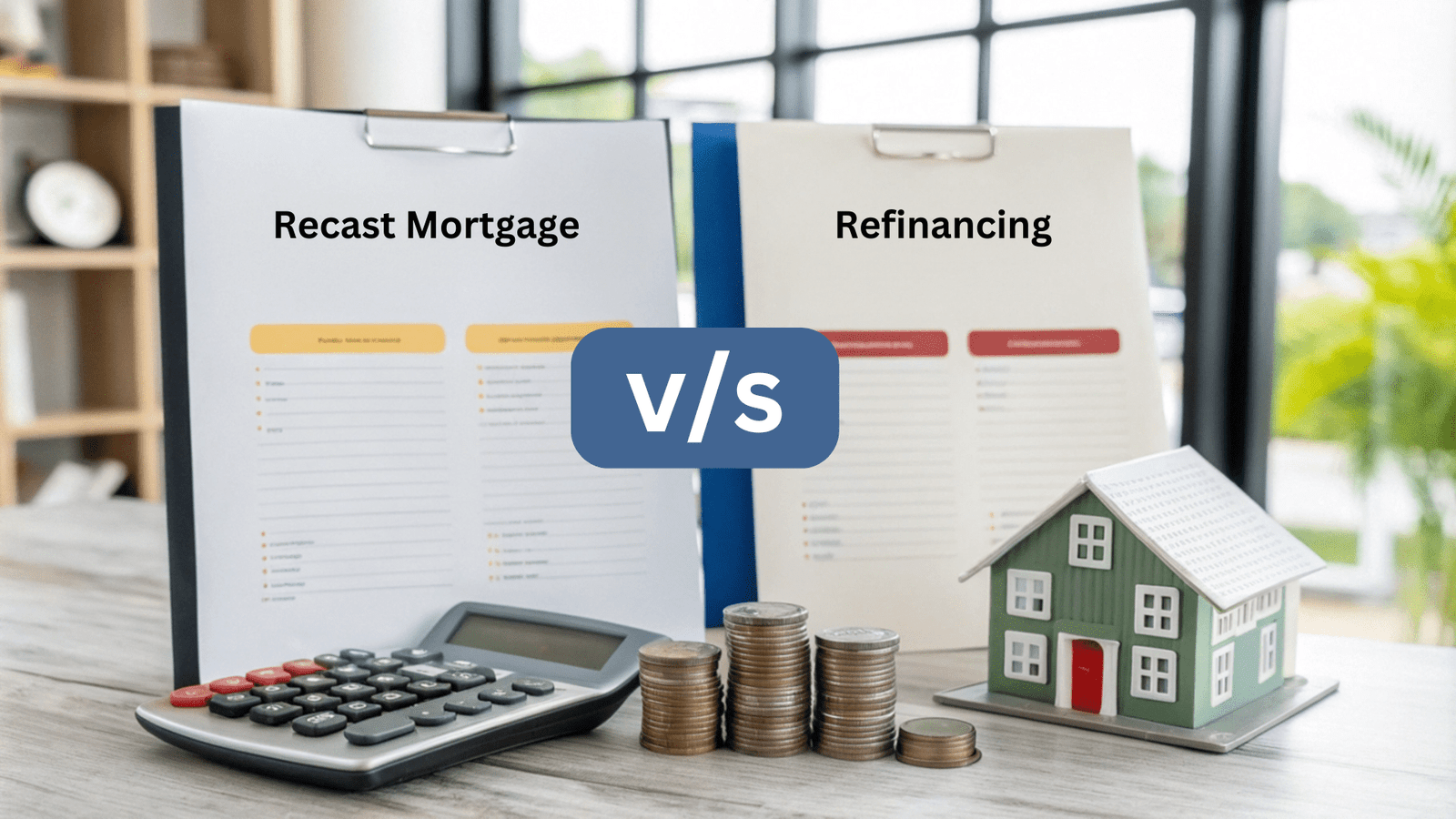Managing your home loan effectively often comes down to two key options: Mortgage Recast vs Refinancing. Recasting involves making a lump-sum payment to reduce your loan balance, lowering monthly payments while keeping your current interest rate and loan terms. Refinancing replaces your existing mortgage with a new one, potentially offering different interest rates, terms, or the option to cash out equity.
Understanding the differences between mortgage recasting vs refinancing can help you decide which strategy is better suited to your financial goals—whether it’s lowering monthly payments, adjusting loan terms, or taking advantage of better interest rates.
Table of Contents
ToggleUnderstanding Your Options
Are you looking to lower your monthly mortgage payments but not sure where to start? Many homeowners face similar dilemmas, often considering whether to recast their mortgage or refinance it. Both methods can be effective, but they work differently and suit specific situations.
By understanding the ins and outs of mortgage recasting and refinancing, you can identify which option aligns better with your financial goals.
What Is a Mortgage Recast?
A mortgage recast (or re-amortization) involves making a one-time, lump-sum payment toward your mortgage principal. Your lender then recalculates your monthly payments based on the new, lower loan balance—but your loan term and interest rate stay the same.
Key Benefits of Recasting
- Lower monthly payments without extending the loan term.
- Minimal fees ($250–$500 typically).
- No credit check or appraisal required.
- Keeps your current interest rate and loan structure.
Limitations
- Requires a substantial lump sum upfront.
- Does not change your interest rate.
- Not offered by all lenders.
What Is Mortgage Refinancing?
Refinancing replaces your existing mortgage with a new one—which may have a different interest rate, loan term, or even allow you to cash out home equity.
Key Benefits of Refinancing
- Opportunity to secure a lower interest rate.
- Adjust your loan term (shorten or extend).
- Remove private mortgage insurance (PMI) if your equity exceeds 20%.
- Access cash for large expenses through a cash-out refinance.
Limitations
- Higher closing costs ($3,000–$6,000+).
- Requires a full loan application, credit check, and appraisal.
- Takes longer to process (30–45 days).
- Savings depend on current market rates.
Recasting vs. Refinancing: Key Differences Explained
Mortgage recasting is a low-cost option that doesn’t require a credit check or appraisal and allows you to reduce your monthly payments simply by making a large one-time payment toward your principal. It is ideal for homeowners who have a lump sum available and are happy with their current interest rate. Since the loan term and rate stay the same, this option works best when market rates are not significantly lower than your existing rate.
Refinancing, on the other hand, is more comprehensive. It involves replacing your existing mortgage with a new one, offering the opportunity to secure a lower interest rate, change the loan duration, remove PMI, or access cash via a cash-out refinance. However, this comes with higher upfront costs and a more involved approval process. Refinancing is better suited for homeowners who want to take advantage of lower market rates or need more flexible loan terms.
Real-World Scenarios
1: Recasting
Sarah inherited $75,000 and wanted to lower her mortgage payments without changing her 3.25% interest rate. She recast her mortgage with a $350 fee and reduced her monthly payment by $325. The entire process took just 10 days.
2: Refinancing
Michael had a 5% mortgage rate. When market rates dropped to 3.75%, he refinanced. He paid $4,000 in closing costs but reduced his monthly payment by $275. He broke even in 15 months and saved tens of thousands over the loan’s life.
- Your current rate is already competitive.
- You want to lower payments with minimal paperwork or cost.
- You want to avoid a full refinance process.
When to Choose Mortgage Refinancing
Refinance if:
- Market interest rates are significantly lower than yours.
- You want to change your loan term (shorten or extend).
- You need to eliminate PMI.
- You want to access home equity.
Key Decision Factors
Ask yourself:
- Do I have enough for a lump sum (recast) or closing costs (refinance)?
- Are current market rates better than my current rate?
- Do I want to change the loan duration or tap equity?
- How long do I plan to stay in my home?
- What is my credit score and home equity position?
Use Online Tools
Consider using mortgage calculators to compare both scenarios based on your loan details. A financial advisor or mortgage professional can also provide tailored recommendations.
Final Takeaway
Both mortgage recasting and refinancing can reduce your monthly mortgage payments, but the right choice depends on your financial situation and goals. Recasting offers quick savings with low hassle if you have cash on hand. Refinancing offers more flexibility and bigger long-term savings—especially when rates drop.
Evaluate your needs and run the numbers to decide which path offers the most benefit for your home financing journey.

